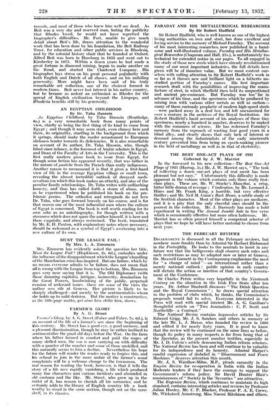FARADAY AND HIS METALLURGICAL RESEARCHES By Sir Robert Hadfield
Sir Robert Hadfield, who is well known as one of the highest living authorities on iron and- steel, has done excellent and loving service to the memory of Michael Faraday. The account of his most -interesting researches, now published in a hand- ' some and well-illustrated volAme, Faraday and His Metallur- gical Researches (Chapman and Hall, 21s.), is unfortunately too technical for extended notice in our pages. To all engaged in the study of those new steels which have already revolutionized many of our most important industries, the full details here given will be of immense value. But we must content our- , selves with calling attention to Sir Robert Hadfield's work in so- far as it throws new and brillitAtt -light on a hitherto un- studied portion of Faraday's career. His first important research dealt with the possibilities of improving the manu- facture of steel, in which Sheffield .then held its unquestioned and ancient pre-eminence. But 'Faraday -was toot far in advance Of his time, and the speeiniens which' he produced by mixing iron with -various other metals as Well as carbon many of them curiously prophetic of modern high-speed steels —were packed away in a deal box and left unexamined for over a century in the archives of the Royal Institution. Sir Robert Hadfield's lucid account of his analyses of these tiny specimens, nearly a hundred in number, deserves to be ranked with the romances of science. He has redeemed Faraday's memory from the reproach of wasting four good years in a blind alley, and clearly shows that only lack of interest or demand among the industrialists of the early nineteenth century prevented him from being an epoch-making pioneer in the field of metallurgy- as well as in that of electricity.






































 Previous page
Previous page